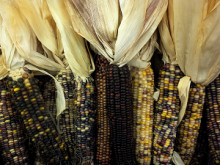Article
The Corn Maidens of Zuni personify the bounty of life giving corn that grows in six colors. The Seven maidens made corn seeds from rubbing the flesh off their body. Early on, insulted by the lascivious gyrations of the male dancers and flute players, the Corn Maidens fled to the land of everlasting summer. It is their breath that brings the rain and warm breezes of summer to the lands of winter. In the legend, the Corn Maidens return to dance when the corn is a foot high. In some legends the sisters perish in a fire that scorches the earth and in others, they become the seven stars of the Big Dipper. In Zuni mythology, the Corn Maidens are often dancing and the Zuni Molawai ritual dramatizes the loss and recovery of the Corn Maidens on the first day of the December Shalaka ceremony.
The Yellow Corn Maiden symbolizes the north; the Blue Corn Maiden represents the west; Red Corn Maiden represents the south; White Corn Maiden is of the east; the speckled Corn Maiden stands for the zenith; and the Black Corn Maiden for the nadir. Each maiden accompanied the Shiwani, or rain priests, to their homes in the respective directions.
"Indian Corn" by arbyreed is licensed under CC BY-NC-SA.
Manuscripts
A03 The Boy Who Made Dragonfly (06-08) p.11
A03 The Boy Who Made Dragonfly (06-08) p.13
A03 The Boy Who Made Dragonfly (06-08) p. 15
A03 The Boy Who Made Dragonfly (06-08) p.16
A03 The Boy Who Made Dragonfly (06-08) p. 17
A03 The Boy Who Made Dragonfly (06-08) p.18
A03 The Boy Who Made Dragonfly (06-08) p. 19
A03 The Boy Who Made Dragonfly (06-08) p. 20
A03 The Boy Who Made Dragonfly (06-08) p.22
A03 The Boy Who Made Dragonfly (06-08) p. 24
A03 The Boy Who Made Dragonfly (06-08) p.26
A03 The Boy Who Made Dragonfly (06-08) p. 43
A03 The Boy Who Made Dragonfly (06-08) p. 44
A03 The Boy Who Made Dragonfly (06-08) p. 45
A03 The Boy Who Made Dragonfly (06-08) p. 46
A03 The Boy Who Made Dragonfly (06-08) p. 47
A03 The Boy Who Made Dragonfly (06-08) p. 48
A03 The Boy Who Made Dragonfly (06-08) p. 49
A03 The Boy Who Made Dragonfly (06-08) p. 51
A03 The Boy Who Made Dragonfly (06-08) p. 52
A03 The Boy Who Made Dragonfly (06-08) p. 54
A03 The Boy Who Made Dragonfly (06-08) p. 55
A03 The Boy Who Made Dragonfly (06-08) p. 58
A03 The Boy Who Made Dragonfly (06-08) p. 59
References
Cushing, Frank Hamilton
1920 Zuñi breadstuff. New York: Museum of the American Indian, Heye Foundation.
Lynch, Patricia Ann
2004 Corn Maidens. Native American Mythology, Mythology A to Z. New York: Facts On
File, Inc.
Young, M. Jane
1987 Women, Reproduction, and Religion in Western Puebloan Society. The Journal of
American Folklore. 100(398): 436-445.

